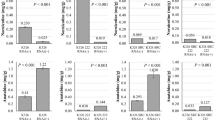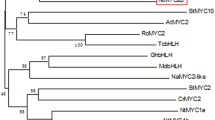Abstract
Main conclusion
The role of six alkaloid biosynthesis genes in the process of nicotine accumulation in tobacco was investigated. Downregulation of ornithine decarboxylase, arginine decarboxylase, and aspartate oxidase resulted in viable plants with a significantly lower nicotine content.
Abstract
Attenuation of nicotine accumulation in Nicotiana tabacum was addressed upon the application of RNAi technologies. The approach entailed a downregulation in the expression of six different alkaloid biosynthesis genes encoding upstream enzymes that are thought to function in the pathway of alkaloid and nicotine biosynthesis. Nine different RNAi constructs were designed to lower the expression level of the genes that encode the enzymes arginine decarboxylase, agmatine deiminase, aspartate oxidase, arginase, ornithine decarboxylase, and SAM synthase. Agrobacterium-based transformation of tobacco leaves was applied, and upon kanamycin selection, T0 and subsequently T1 generation seeds were produced. Mature T1 plants in the greenhouse were topped to prevent flowering and leaf nos. 3 and 4 below the topping point were tested for transcript levels and product accumulation. Down-regulation in arginine decarboxylase, aspartate oxidase, and ornithine decarboxylase consistently resulted in lower levels of nicotine in the leaves of the corresponding plants. Transformants with the aspartate oxidase RNAi construct showed the lowest nicotine level in the leaves, which varied from below the limit of quantification (20 μg per g dry leaf weight) to 1.3 mg per g dry leaf weight. The amount of putrescine, the main polyamine related to nicotine biosynthesis, showed a qualitative correlation with the nicotine content in the arginine decarboxylase and ornithine decarboxylase RNAi-expressing transformants. A putative early senescence phenotype and lower viability of the older leaves was observed in some of the transformant lines. The results are discussed in terms of the role of the above-mentioned genes in the alkaloid biosynthetic pathway and may serve to guide efforts to attenuate nicotine content in tobacco leaves.











Similar content being viewed by others
Abbreviations
- ADC:
-
Arginine decarboxylase
- AIC:
-
Agmatine deiminase
- AO:
-
Aspartate oxidase
- ARG:
-
Arginase
- ODC:
-
Ornithine decarboxylase
- SAM:
-
S'adenosyl-L:-methionine
- WT:
-
Wild type
References
Bai Y, Pattanaik S, Patra B, Werkman JR, Xie CH, Yuan L (2011) Flavonoid-related basic helix-loop-helix regulators, NtAn1a and NtAn1b, of tobacco have originated from two ancestors and are functionally active. Planta 234(2):363–375
Baldwin IT (1989) Mechanism of damage-induced alkaloid production in wild tobacco. J Chem Ecol 15:1661–1680
Bortolotti C, Cordeiro A, Alcázar R et al (2004) Localization of arginine decarboxylase in tobacco plants. Physiol Plant 120:84–92. https://doi.org/10.1111/j.0031-9317.2004.0216.x
Chintapakorn Y, Hamill JD (2007) Antisense-mediated reduction in ADC activity causes minor alterations in the alkaloid profile of cultured hairy roots and regenerated transgenic plants of Nicotiana tabacum. Phytochemistry 68:2465–2479
DeBoer KD, Dalton HL, Edward FJ, Hamill JD (2011) RNAi-mediated downregulation of ornithine decarboxylase (ODC) leads to reduced nicotine and increased anatabine levels in transgenic Nicotiana tabacum L. Phytochemistry 72:344–355
DeBoer KD, Dalton HL, Edward FJ, Ryan SM, Hamill JD (2013) RNAi-mediated down-regulation of ornithine decarboxylase (ODC) impedes wound-stress stimulation of anabasine synthesis in Nicotiana glauca. Phytochemistry 86:21–28
Dewey RE, Xie J (2013) Molecular genetics of alkaloid biosynthesis in Nicotiana tabacum. Phytochemistry 94:10–27
El Amrani A, Couée I, Berthomé R et al (2019) Involvement of polyamines in sucrose-induced tolerance to atrazine-mediated chemical stress in Arabidopsis thaliana. J Plant Physiol 238:1–11. https://doi.org/10.1016/j.jplph.2019.04.012
Goodspeed TH, Clausen RE (1928) Interspeeific hybridization in Nicotiana, VIII. The sylvestris-tomentosa-tabacum hybrid and its bearing on the origin of tobacco. Univ Calif Pub Bot 11(13):243–256
Gray JC, Kung SD, Wildman SG, Sheen SJ (1974) Origin of Nicotiana tabacum L. detected by polypeptide composition of fraction I protein. Nature 252:226–227
Henry JB, Vann MC, Lewis RS (2019) Agronomic practices affecting nicotine concentration in flue-cured tobacco: a review. Agron J 111:1–9
Jumtee K, Bamba T, Okazawa A et al (2008) Integrated metabolite and gene expression profiling revealing phytochrome A regulation of polyamine biosynthesis of Arabidopsis thaliana. J Exp Bot 59:1187–1200. https://doi.org/10.1093/jxb/ern026
Kajikawa M, Sierro N, Kawaguchi H, Bakaher N, Ivanov NV, Hashimoto T, Shoji T (2017) Genomic insights into the evolution of the nicotine biosynthesis pathway in tobacco. Plant Physiol 174(2):999–1011
Kirst H, Shen YX, Vamvaka E, Betterle N, Xu DM, Warek U, Strickland JA, Melis A (2018) Downregulation of the CpSRP43 gene expression confers a truncated light-harvesting antenna (TLA) and enhances biomass and leaf-to-stem ratio in Nicotiana tabacum canopies. Planta 248:139–154
Kung SD, Sakano K, Gray JC, Wildman SG (1975) The evolution of fraction I protein during the origin of a new species of Nicotiana. J Mol Evol 7(1):59–64
Kwak SH, Lee SH (2001) The regulation of ornithine decarboxylase gene expression by sucrose and small upstream open reading frame in tomato (Lycopersicon esculentum Mill). Plant Cell Physiol 42:314–323. https://doi.org/10.1093/pcp/pce040
Leete E (1977) Biosynthesis and metabolism of the tobacco alkaloids. Proc Am Chem Soc Symp 173:365–388
Moghbel N, Ryu B, Ratsch A, Steadman KJ (2017) Nicotine alkaloid levels, and nicotine to nornicotine conversion, in Australian Nicotiana species used as chewing tobacco. Heliyon 3(11):e00469
Murashige T, Skoog F (1962) A revised medium for rapid growth and bioassays with tobacco tissue cultures. Physiol Plant 15:473–497
Patel RK, Patel JB, Trivedi PD (2015) Spectrophotometric method for the estimation of total alkaloids in the Tinospora cordifolia M. and its herbal formulations. Int J Pharm Pharm Sci 7:249–251
Patra B, Schluttenhofer C, Wu Y, Pattanaik S, Yuan L (2013) Transcriptional regulation of secondary metabolite biosynthesis in plants. Biochim Biophys Acta 11:1236–1247
Payyavula RS, Navarre DA, Kuhl J, Pantoja A (2013) Developmental effects on phenolic, flavonol, anthocyanin, and carotenoid metabolites and gene expression in potatoes. J Agric Food Chem 61(30):7357–7365
Payyavula RS, Navarre DA, Kuhl JC, Pantoja A, Pillai SS (2012) Differential effects of environment on potato phenylpropanoid and carotenoid expression. BMC Plant Biol 12:39. https://doi.org/10.1186/1471-2229-12-39
Saitoh F, Nona M, Kawashima N (1985) The alkaloid contents of sixty Nicotiana species. Phytochemistry 24:477–480
Singh SK, Wu Y, Ghosh JS, Pattanaik S, Fisher C, Wang Y, Lawson D, Yuan L (2015) RNA-sequencing reveals global transcriptomic changes in Nicotiana tabacum responding to topping and treatment of axillary-shoot control chemicals. Sci Rep 5:18148
Sisson VA, Severson RF (1990) Alkaloid composition of the Nicotiana species. Beitr Tabakforsch 14:327–339
Smith HH (1968) Recent cytogenetic studies in the genus Nicotiana. Adv Genet 14:1–54
Tayoub G, Sulaiman H, Alorfi M (2015) Determination of nicotine levels in the leaves of some Nicotiana tabacum varieties cultivated in Syria. Herba Pol 61(4):23–30
Tso TC, Jeffrey RN (1961) Biochemical studies on tobacco alkaloids. IV. The dynamic state of nicotine supplied to N. rustica. Arch Biochem Biophys 92:253–256
Waese J, Fan J, Pasha A et al (2017) ePlant: visualizing and exploring multiple levels of data for hypothesis generation in plant biology. Plant Cell 29:1806–1821. https://doi.org/10.1105/tpc.17.00073
Waller GR, Nowacki EK (1978) Alkaloid biology and metabolism in plants. Plenum Press, New York
Acknowledgements
We thank Christina Wistrom and her staff for the greenhouse support she provided during the cultivation and growth of both the T0 and T1 tobacco plants. We also wish to thank Jason W. Flora, Mingda Zhang, and Jesse Frederick for reading and commenting on the manuscript. Funding was provided by UCB grant (85992-13618-44-ME1AM).
Author information
Authors and Affiliations
Corresponding author
Ethics declarations
Conflict of interest
The authors declare that they have no conflict of interest.
Human participants and/or animals
Research did not involve human and/or animal subjects. Experimental protocols in this work were approved by the UC Berkeley Committee on Laboratory and Environmental Biosafety (CLEB).
Informed consent
All authors have read and approved the submission of this work.
Additional information
Publisher's Note
Springer Nature remains neutral with regard to jurisdictional claims in published maps and institutional affiliations.
Electronic supplementary material
Below is the link to the electronic supplementary material.
Rights and permissions
About this article
Cite this article
Hidalgo Martinez, D., Payyavula, R.S., Kudithipudi, C. et al. Genetic attenuation of alkaloids and nicotine content in tobacco (Nicotiana tabacum). Planta 251, 92 (2020). https://doi.org/10.1007/s00425-020-03387-1
Received:
Accepted:
Published:
DOI: https://doi.org/10.1007/s00425-020-03387-1




